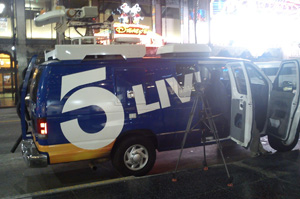

It takes hundreds of people, working in a range of different capacities, to produce a news bulletin of any scale. Each person fulfils a specific role, and in a smaller TV station, may fulfil several. The process of gathering and presenting news is one that is subjected to constant change, most recently in terms of technology. As equipment becomes smaller, lighter and needs less people to operate it, the nature of the news team has changed - teams of three (reporter, camera & sound) can now be despatched to cover an event. However, the demand for instant news means that broadcast quality footage may need to be relayed live from location. and that three person reporting team may need the backup of some serious hardware and software.
A career in news is attractive to many - but it's a competitive business. News reporters outside the studio must be well-informed, resourceful, and prepared to put up with harsh conditions that may range from wind and rain to gunfire. These brave men and women are often identified as the 'face' of the news, and many of them take their professional responsibilities very seriously indeed. Read more about
Christiane Amanpour (former Chief International Correspondent for CNN, now anchor for ABC's Sunday morning news)
You can check out details on all the BBC news staff here.
News Analysts, Reporters & Correspondents - US Dept of Labor statistics
TV news audiences demand up-to-the-minute global news, particularly in times of international crisis. There are a few global news organisations that can provide this (CNN, BBC) but others need to buy footage from a news agency, which runs news bureaux in cities around the world.

For analysing TV news consider:
News has its own codes and conventions, and is instantly recognisable when you encounter it channel hopping. News is seen as a high status genre of programming (much more so than soap opera, for instance) with a high level of responsibility towards its audience. Journalists take pride in following a code of ethics, and will try to balance public interest with the demands of the network – not always an easy job.
TV news has a style of camerawork all its own. We are familiar with the concept of the news crew, consisting of a reporter, camera operator(s), and sound recordist(s), arriving at situations as news happens, in order to beam back the most accurate and up-to-date pictures to viewers. For an important news event, footage is broadcast through a live feed, giving little or no opportunity for editing as we would normally understand it. We accept that TV camerawork is often hand held, that we may not get the same quality of image (largely because of lighting) that we are used to with scripted drama. However, it is worth considering that these images are mediated. Decisions have been made on a very basic level about where to go, when to switch the camera on and off, where to point it, who to talk to and how to frame shots. TV crews have miniature outside broadcast units containing the latest technology, and many reports are edited in the field. TV news footage should never be interpreted as the simple recording of an event, no matter how objective the camera operator tries to be. The images are selected to tell a story, and should be judged as subjective, even before the commentary of a reporter or anchor further fixes the meaning of what we see and hear. The reality we see in TV news is sometimes as elaborately constructed as a Hollywood movie.
Although TV news relies heavily on images to communicate stories, language is just as important. headlines are read at the beginning of each bulleting and each story, and these headlines are as significant as their counterparts in newspapers, often employing the same sort of figurative language, or stylistic devices such as alliteration. Newsreaders' scripts are carefully written to communicate the facts, as are reporters posts.
As well as analysing the news itself, you should be aware of the institution which has produced that news, and the criticisms aimed at its reporting. News is a very political media form, and you must read it, and those who criticise it, very carefully. TV news, like any other media form, is packaged to appeal to an audience, the only difference perhaps being that we cannot get our TV news from such a wide variety of sources as we can other media. TV news organisations are, by and large, commercial operations (even the BBC!) and must operate within budgets, and ideally turn a profit from advertising. News programming is a vital part of TV scheduling, designed to draw in a broad audience (prime time news often gets the biggest ratings of an evening), and is subject to competition from other news providers.
News presenters represent the values of the organisation they work for onscreen. It is always useful to analyse the appearance of those who are given the responsibility of communicating the news - are they smartly dressed, with conventional and conformative suit and hair? Or are they slightly less predicitable, reporting from a dangerous location in casual clothes with hair in disarray? Their age, accent and ethnicity will give an indication of the range of audience a news organisation is trying to attract.